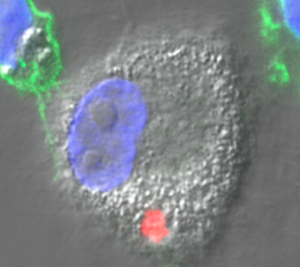Here I am talking about how to make a game out T cells and Macrophages. I am speaking with Alec Redwood, an Australian virologist and immunologist who was in Seattle for a few weeks. We discuss the interactions between Macrophages and the adaptive immune system and how we built a game around these molecular mechanisms.
The cool part is that the game and the biology both work out to a story about the great hero, Macrophage. Like the great Greek hero Cassandra, Macrophages can see danger. Macrophages have an ability that is greater than any other cell type in your body. They are built to respond, with receptors that specifically bind to molecules that are only found on bacteria and other pathogens. Macrophages, our hero, roams over the whole body watching for danger. And when they find it, Macrophages start communicating about the pathogen. However, unlike the hapless Cassandra, Macrophages also have the incredible power to get other cells to listen to them and make them believe what they say. Cassandra was left to cry alone, while men she tried to warn were killed as she predicted. But Macrophage, our hero, has receptors that grab onto T-Cells and don’t let go until the T-Cell is good and alarmed! Ah, the powerful Macrophage. Tracking, catching, eating, dissolving hundreds of pathogens and then alarming the rest of the cellular army… Pathogens are trying to avoid you at each of these steps! Will you be successful? Will you clear the field before inflammation does permanent damage to the body you protect? We ask the question immunologists have asked for hundreds of years: Can we help you, Macrophage? Will our technology be enough to rise to your sophistication, to fight beside you at last? May we join you in your epic quest for peace, can we fight with you in the oldest battle on Earth?
Footnotes:
1. “Cassandra”. Mortal Women of the Trojan War. Stanford University. RetrievedMarch 24, 2014. Wikipedia, Cassandra
2. Macrophages were first discovered by Élie Metchnikoff, a Russian bacteriologist, in 1884[1]

Read more about this Macrophage (Center) in Sebastian Giese’s paper in the free Journal PLoS Pathogens, vol 10, page e1004189.


[…] RT @Mac_The_Phage: I am a hero!!! Play my video game and see! http://t.co/ZEJGvGUUBw #science #Immunology #ascb2014 […]